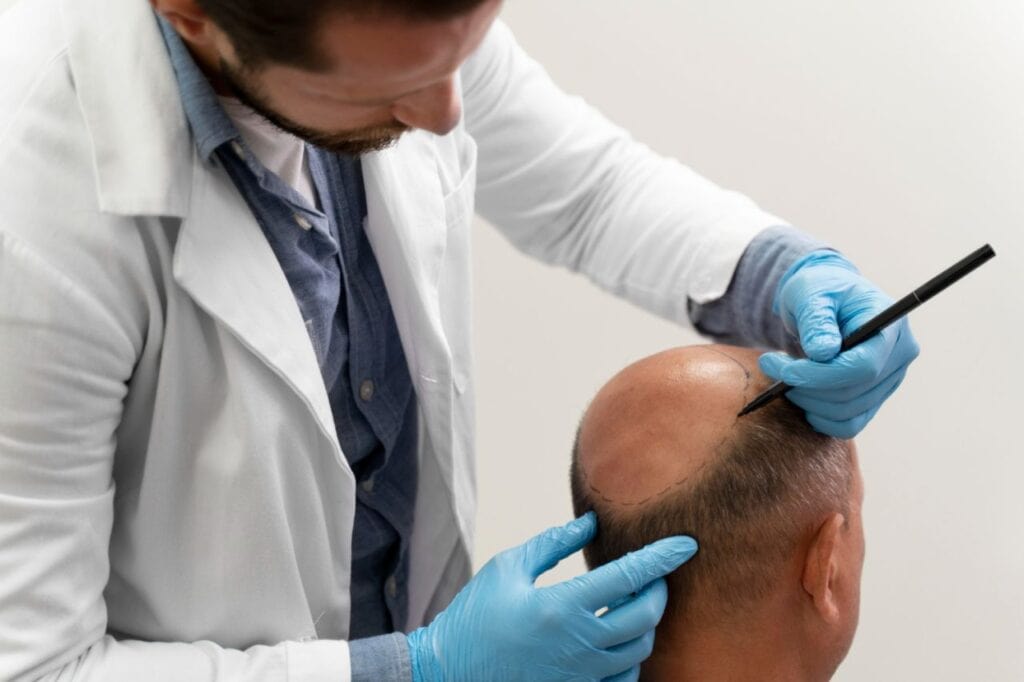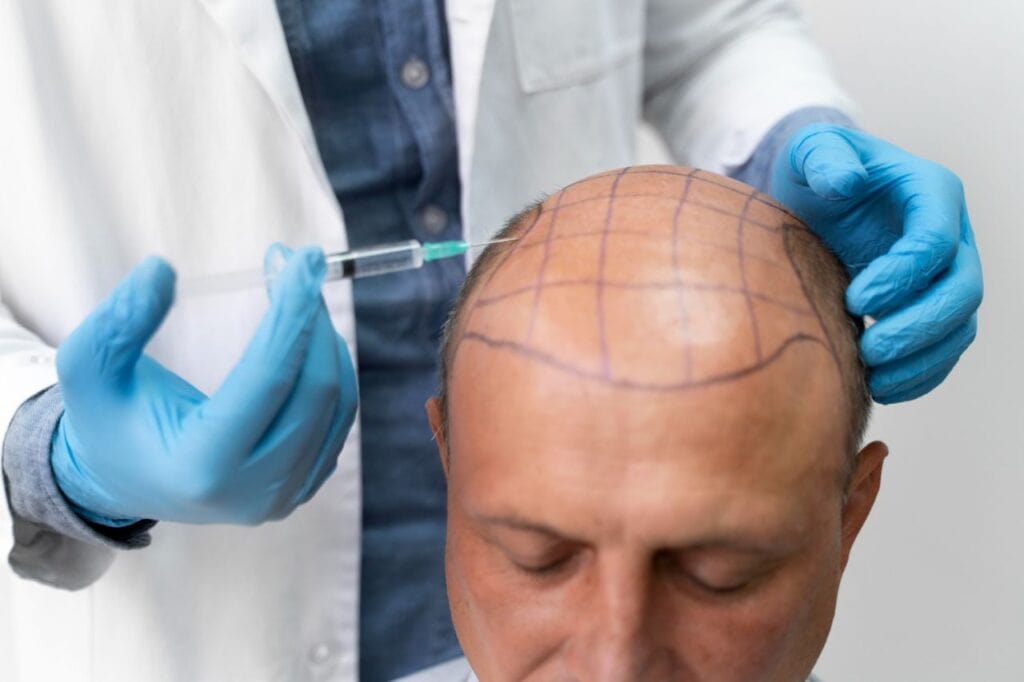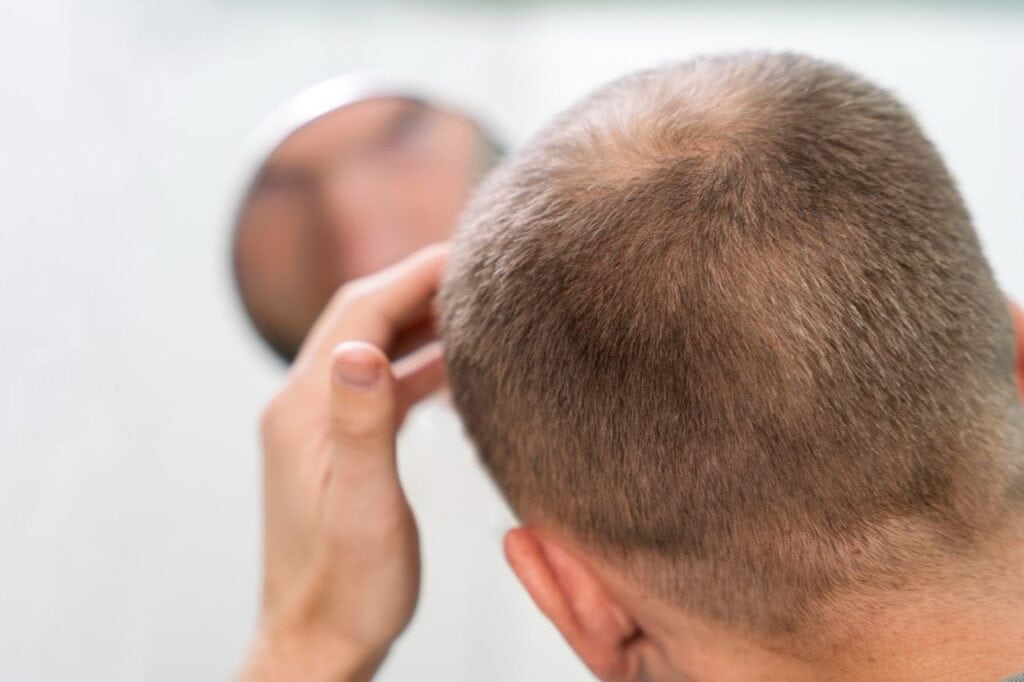Many men losing their hair have adopted the slogan "Don't be bald!" as their rallying cry. The appearance of baldness can be concealed by several treatments, including medication and surgery, but some men may still choose to shave their heads.
Hair transplant surgery is an option for those unhappy with their thinning hair or balding areas. To be sure, what exactly is a hair transplant? To that end, what potential downsides and hazards should we be aware of? To help you decide if a hair transplant is a suitable choice for you, we'll address these and other concerns in this post.
Overview
Hair transplants are a surgical procedure that can restore fullness to balding or thinning areas of the scalp. Hair grafting involves transplanting hair from one area of the scalp or another body site to a balding or thinning area of the scalp.
Roughly 60% of men and 50% of women experience hair loss. Products like minoxidil, a topical treatment, are commonly purchased from drugstores and grocery stores to combat this (Rogaine).
One other method of restoration is hair transplantation. It was in Japan in 1939 that you attempted the first successful transplant of a single scalp hair. Later decades saw medical professionals' development of the "plug" technique. Large clumps of fur are surgically implanted.
Mini- and micro-grafts have been used by surgeons to conceal hair transplants on the scalp more effectively in recent years.
Is Hair Transplant Worth It?
It is also essential to have reasonable hopes for the outcome of your hair transplant.
In contrast, if you have only minor hair loss and a substantial amount of donor hair on your head, a hairline transplant may help reverse years of hair loss and improve your appearance. The surgery won't eliminate the need for proactive care for your hair's health and appearance afterwards.
This thing claims to change your life forever; can you put your faith in it? Will it make a difference in your life? Putting it succinctly, should you get a hair transplant?
It's normal to feel frustrated by your thinning hair and consider drastic measures because there is no clear-cut answer to choose from. Spending time and energy is not cheap.
Maybe you're thinking about this now that you've had the operation. It's a lot to take in and process emotionally.
Better Appearance Satisfaction
After undergoing a hair transplant procedure, many patients report feeling more confident. While undergoing hair loss, they experience a sense of shame about their appearance. They are primarily unhappy with how they look.
One of the best ways to determine if a hair transplant system is right for you is to learn about the experiences of those who have already gone through with the operation. An overwhelming majority of its buyers are satisfied.
According to the FACE-Q rating, patients who received hair transplants reported feeling about six years younger than their true age, as shown in a 2019 study. Incredibly, the percentage of satisfied patients with their outward look increased significantly. Their mental and social well-being improved as a result.
The results of hair transplant surgery will vary from person to person for a number of reasons.
It emphasises the value of open dialogue between patient and surgeon before hair transplantation. You should be clear with the hair transplant surgeon about what you hope to achieve. The results of a psychological evaluation of the patient are also relevant here.
Permanent Solution To Permanent Hair Loss

Hair transplantation surgery provides long-lasting results due to the precision of the procedure. It takes advantage of your naturally occurring hair unaffected by the hormone dihydrotestosterone (DHT).
Hair transplants rely on extracting hair follicles from donors. In some situations, multiple operations may be required. It, however, is done solely to aid in pursuing their ideal physical form.
Of fact, there are cases where hair loss can be reversed. If your hair's roots aren't healthy, no amount of vitamins or minerals will revive them and promote growth. Only hair transplant surgery can permanently stop hair loss. So yes, a hair transplant is a good investment of time and money in this scenario.
Realistic Results
Wigs were once favoured over hair transplants by the general public. The reason is the doll-like appearance of the recipient's head after a hair transplant. It was easy to tell from a casual glance at someone's hairstyle whatever they did to their scalp.
Furthermore, it made some of them an object of ridicule. Follicular unit transplantation (FUT) improved outcomes, but follicular unit extraction (FUE) yielded the most desirable results (FUE).
In follicular unit transplantation, the newly transplanted hair blends seamlessly with the patient's natural hair. Concerns about scarring and artificial appearance are also moot. The process of hair transplantation is continually being refined.
There are times when constraints prevent us from providing the best possible care to our patients. Thus, modern hair transplant surgeons frequently supplement hair transplants with additional procedures. Platelet-rich plasma injections are the first option.
After six months, all 20 patients who underwent follicular unit extraction had achieved greater than 75% hair growth, while only four patients in the control group had done so.
In contrast to the control group, PRP-injected patients saw an increase in hair density of greater than 75% in a matter of weeks. Moreover, their hair grew longer, and their scalps healed more quickly. That's why doctors advise PRP treatment alongside hair transplant surgery.
Can we say that hair transplantation on its own is financially viable? Supplemental treatments, such as platelet-rich plasma (PRP), can improve hair transplant outcomes and lower failure rates.
Affordability
It is a significant barrier for many people considering a hair transplant. Is it even worth it to get a hair transplant, is what they're primarily wondering. However, restoration surgery has become increasingly commonplace over the years. This factor has increased the price of a hair transplant.
As a result of rising patient interest, more and more hospitals and surgical centres are beginning to offer this procedure, driving down average costs. Even so, there remains a wide range of possibilities depending on location, design, and outcome goals.
For those whose hair loss is only temporary, it is not necessary to undergo it. Hair regrowth is possible with or without medication in some cases.
Most people who suffer from male-pattern baldness opt for surgical intervention. But restoration surgery may be an option for those who have lost their hair permanently due to an accident or medical treatment.
However, the surgeon won't be able to safely remove hair follicles from the patient's scalp if the donor area is too frail. It is especially true if they are experiencing extensive baldness, which involves hair loss in zones 1-7.
Donor hair cannot fill in the bald spots in this case. There is a risk that a hair transplant of this type will produce disastrous results. Furthermore, you will waste the patient's time and money.
Furthermore, your surgeon may refuse to proceed with the procedure if you have extensive keloid scarring on your scalp. You may not advise getting a hair transplant because of the risk of keloids developing on your scalp after surgery.
Patients with infectious diseases or other potentially life-threatening illnesses are also not good candidates for this procedure.
Having reasonable expectations for the operation is essential. If you don't, you might be disappointed. Do you mean density or coverage when you say "full head of hair?"
Since a lack of donor space precludes both high density and complete coverage, the doctor will give you this information before the operation.
Even after a hair transplant, some loss of hair may occur. When it becomes excessive enough to cause thinning, a second operation may be necessary 5-10 years later.
As an additional note, success is a give-and-take process. The success of any surgical procedure depends on several factors, including the surgeon's abilities and the patient's adherence to postoperative care. Don't anticipate typical hair growth to resume immediately after a hair transplant.
Follow your surgeon's orders to ensure a smooth recovery from hair transplant surgery. It can help you decide if a hair transplant is worthwhile.
Are hair transplants a good investment of time and money? Many who have undergone the procedure would answer with an affirmative. When hair loss is permanent, the only option is a hair transplant.
Finasteride and Minoxidil are FDA-approved treatments for hair loss, but consistent application is necessary to observe results. It's true that there are situations where even these treatments stop working. By comparison, the FUE method allows you to keep your hair permanently.
The methods used to perform this operation are constantly developing and improving. It is becoming increasingly effective at helping patients. By combining PRP injections with hair transplants, patients can see even more significant improvements in hair density and a quicker recovery time.
A sizable subset of the balding population opts for these cosmetic interventions. It considers the expense and the trouble of recovering from the operation.
For many people, these are just minor setbacks on the way to their ultimate goal. For this, having patience is essential, and in the end, you will conclude that your hair transplant was worthwhile.
Old School Hair Transplant
This transplant method calls for removing a long football-shaped section of hairless, bald-proof skin from the lower back of the recipient's head.
After the skin is reattached using sutures, a permanent scar will remain that, in most cases, can be covered by hair. Under binocular microscopes, two nurses or technicians typically dissect individual follicles from the skin flap.
Follicles typically produce one to three hairs, and occasionally even four. The technicians will put one of each kind into a petri dish. Meanwhile, the anaesthetised patient watches intently as the surgeon makes tiny holes in the scalp, paying particular attention to the desired direction of hair growth.
Cuts will be made in a direction that corresponds with where the growth should go. The surgeon will then begin implanting them at the hairline after collecting them. After that comes a wave of twos, and finally, most fill is done with threes.
What Exactly Is the Hair Transplant Process?
Hair is taken from parts of the scalp that are not affected by male pattern baldness and transplanted into bald or thinning spots.
In order for hair transplants to be successful, it is necessary for the main hormone responsible for baldness, DHT, to not damage all of the hair on your head. A hair transplant surgeon can bring the DHT-resistant hairs from the back and sides of your head forwards, giving you a fuller, thicker head of hair.
Hair transplants previously involved removing and reimplanting "plugs," or groups of hair follicles, to recreate the desired hairline.
Hair plugs are effective in hiding a receding hairline, but their artificial appearance is heightened because hair transplants are typically performed in multiple locations, with an obvious space between each "plug."
Hair transplants have advanced significantly in recent years. With FUE or FUT, surgeons can remove follicles from the scalp and transplant them into the recipient site in groups of one to three hairs, recreating a natural-looking hairline.
The hairline created by a skilled surgeon can appear and feel much like your natural hairline if you have sufficient donor hair and the ability to develop hair in the balding areas of your head.
How Do FUE And FUT Differ?
It's common to practice using either Follicular Unit Extraction (FUE) or Follicular Unit Transplantation (FUT) to restore hair loss due to surgery.
With a few caveats, the results from either strategy are equivalent. During FUE, tiny "units" of 1-4 hairs are extracted from the scalp using medical equipment.
The absence of a scar after FUE is a major perk of the procedure. This approach generates a large number of microscopic spots that gradually disappear, making it possible for those whose normal strip hair transplant scar is too obvious to hide..
However, FUT necessitates the removal of a smaller amount of skin from the back of the head. A single or more hairs may be removed from this strip simultaneously. An artificial hairline or crown can be created by surgically removing hair follicles from the scalp and replanting them on top of the head.

FUE hair transplants are not as successful as FUT hair transplants. In contrast, FUT results in a more noticeable scar on the back of the scalp, especially when the hair is short or shaved off completely. Furthermore, the success of any surgery is highly dependent on the expertise of the operating surgeon or dermatologist.
Both procedures leave visually exactly the same results in the crown and hairline region; scarring can be covered up by the thick, dark hair at the back of the head.
If you are self-conscious about receding hairline or balding in general, hair transplantation may be a possibility for you..
When performed by a skilled doctor, hairline transplants can bring back your natural hairline and restore your hair's fullness and thickness.
Contrarily, a hair transplant is not a miracle treatment and may not be a long-term answer for baldness. It is essential to go into a hair transplant with realistic expectations, as the procedure does not guarantee a full head of hair.
Here are some things to keep in mind before deciding whether or not to get a hair transplant:
- Scarring is an unavoidable consequence of any hair transplant procedure, including FUE. Scars are the only distinguishing physical feature between individuals (s). The scar left by FUE is a series of tiny, uniformly spaced incisions, while the scar left by FUT is much larger.
- If you have dark, thick hair at the back of your head, the scar from your hair transplant may be completely undetectable.
The success of your hair transplant dramatically depends on the skill and experience of the surgeon who performed it. If you go to the right surgeon, you can expect a dramatic transformation and a hairline that looks completely natural. Like many other cosmetic treatments, hair restoration is best handled by a specialist in the field rather than a general plastic surgeon.
A hairline transplant, on the other hand, may significantly improve the look of your hair in most men. You should set your sights on a realistic goal, given the amount of hair you still have.
Conclusion
Weighing the benefits and risks of hair transplant surgery is crucial before making any final decisions. It is also worth noting that our professional staff is always available to assist you. Please do not be hesitant to contact us with any inquiries or concerns.
FAQs
In what ways does a hair transplant fail?
An effective hair transplant procedure can give you permanent results.
How effective is hair transplantation, generally speaking?
The graft survival rate after a hair transplant is very high, between 90% and 95%.
When is the optimal time for a hair transplant?
Although anyone over 18 can get a hair transplant, most experts recommend waiting until you're at least 25. Given that the pattern of hair loss in younger men is not always clear, they may not be the best candidates.
How effective is hair transplantation, if at all?
According to clinical studies, between eighty-five and ninety-five per cent of grafts implanted in a transplanted area usually grow. This impressive percentage demonstrates that hair transplants have a very high success rate. Some patients worry that the graft will reject them like any other transplant.
Do hair transplants ever go wrong?
Graft rejection, ineligibility for hair transplant, unrealistic expectations, inadequate post-transplant care, and an inexperienced clinic are just some of the causes of hair transplant failure.
An effective hair transplant procedure can give you permanent results.
The graft survival rate after a hair transplant is very high, between 90% and 95%.
Although anyone over 18 can get a hair transplant, most experts recommend waiting until you're at least 25. Given that the pattern of hair loss in younger men is not always clear, they may not be the best candidates.
